What Is 3D Radio Calibration?
Optimized based on traditional radio calibration, 3D radio calibration algorithm can identify complex installation scenarios such as high or blocked AP positions based on RSSI measurement results reported by STAs, and adjust the transmit power and channels accordingly to provide better wireless service experience at these special positions.
What Are the Disadvantages of Traditional Radio Calibration Algorithms?
Basic Principles of Traditional Radio Calibration
During the propagation of electromagnetic waves, the signal strength gradually attenuates with the increase of distance. Such signal attenuation is known as the path loss, which is obtained by subtracting the RSSI measured at the receive end from that measured at the transmit end. A longer transmission distance indicates higher path loss. Air is similar to a homogeneous medium. Therefore, when radio signals are transmitted in the air, the transmission distance can be estimated based on the path loss.
When APs with omnidirectional antennas are deployed in indoor open coverage areas (such as open office areas), a logical two-dimensional (2D) topology can be established based on the path losses between every two APs to simply display the AP-AP neighbor relationship. This is the basis of the traditional radio calibration algorithm.
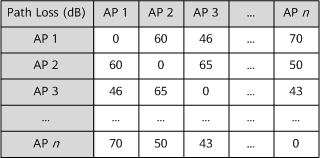
2D relationship of "AP-AP"
If an AP detects high path losses of signals between it and surrounding APs, the calibration algorithm considers that the AP is far away from surrounding APs and therefore increases the radio transmit power on the AP to expand network coverage. Similarly, if the detected path loss is low, the calibration algorithm reduces the radio transmit power on the AP to reduce interference. In addition, to prevent co-channel interference between neighboring APs, the algorithm typically allocates the same working channel to two APs that are far away from each other.
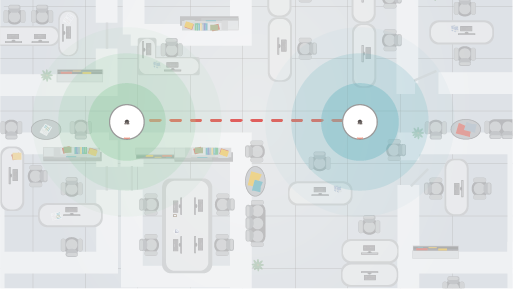
Calibration between neighboring APs
The traditional radio calibration algorithm based on the AP-AP relationship can properly support radio parameter planning in most open space scenarios. In actual project delivery, however, APs are typically installed in complex positions, meaning that obstacles may exist between APs and STAs, and between the APs. In this case, the preceding 2D topology cannot accurately reflect the transmission of radio signals, affecting the calibration effect and degrading user experiences at these special installation positions.
Scenario 1: APs Installed at High Positions Result in Weak Signal Strength of STAs
In most cases, APs on a deployment plane evenly adjust their transmit power to ensure full coverage and interference avoidance. This prevents the high transmit power of an AP from affecting services of neighboring APs. However, if an AP is installed at a high position (more than 5 m away from the ground) or is blocked from STAs by obstacles such as the ceiling, issues such as weak Wi-Fi signal strength, low transmission rates, and roaming disconnection may occur on STAs.

Weak signal strength of STAs
Scenario 2: Co-channel Interference Occurs Between Neighboring APs Blocked from Each Other
The traditional calibration algorithm tries to avoid allocating the same channel to neighboring APs. The path loss between two APs is an important basis for determining the neighbor relationship. If obstacles such as beams and corners that have great impact on signals exist between two physically adjacent APs (the path loss is at least 8 dB higher than that in scenarios without obstacles), the two APs cannot detect each other or have weak perception. The traditional calibration algorithm therefore considers that the two APs are far away from each other and may allocate the same working channel to them. This will lead to strong co-channel interference on STAs and cause the STAs to fail to access the network even if signals are available.

Co-channel interference between neighboring APs
How Does the 3D Radio Calibration Algorithm Solve These Problems?
To solve the preceding problems of traditional calibration algorithms, Huawei develops the 3D radio calibration algorithm. The algorithm uses historical measurement data reported by STAs as a reference to adapt to the preceding complicated space environments. The 3D radio calibration algorithm leverages the link measurement (LM) capability of 802.11k STAs to construct a three-dimensional (3D) topology among APs, STAs, and APs. This topology reflects the transmission of wireless signals in space and the impact of signals on STAs and APs.
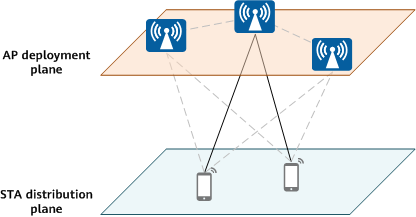
3D relationship of "AP-STA-AP"
Identifying Scenarios Where APs Are Deployed at High Positions and Increasing the Transmit Power
A STA measures the downlink RSSIs of the associated AP and neighboring APs, and reports the results to the AC through the associated AP.

Algorithm optimization in scenarios where APs are deployed at high positions
After sampling for a period of time and excluding data of sticky STAs, the 3D radio calibration algorithm collects statistics on data samples from the associated AP reported by STAs for further analysis. If the downlink RSSI of more than 10% samples is lower than –70 dBm, the AP is considered to be installed at a high position. In this case, the calibration algorithm increases the transmit power of the associated AP so that the strongest RSSI in the 10% samples is greater than or equal to –65 dBm to improve service experience of users.
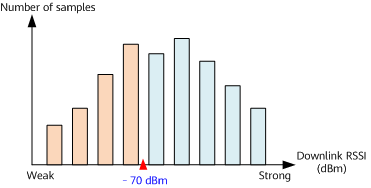
Determining whether an AP is installed at a high position based on the sampled data
Identifying Blocked AP Pairs and Allocating Different Channels
In scenarios where obstacles exist between neighboring APs, the 3D radio calibration algorithm can accurately identify the neighbor relationship between the APs based on the LM measurement results of STAs and allocate different working channels to the APs, thereby ensuring service experience of users.
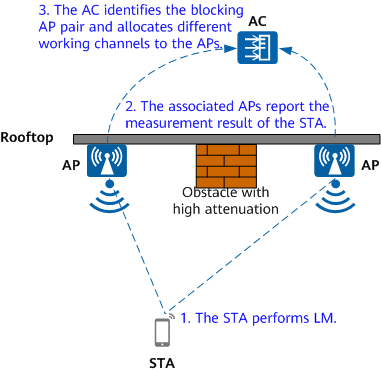
Algorithm optimization for blocked neighboring APs
What Scenarios Does 3D Radio Calibration Apply to?
The 3D radio calibration algorithm is applicable only to wireless office scenarios of enterprise campuses but not to dormitory or warehouse scenarios.
For details about networking requirements, see Radio Resource Management Configuration Guide (SmartRadio) > Understanding Radio Resource Management > Radio Calibration in Wireless Access Controller (AC and Fit AP) Product Documentation.
- Author: Chen Huaxing
- Updated on: 2023-04-27
- Views: 1355
- Average rating:







